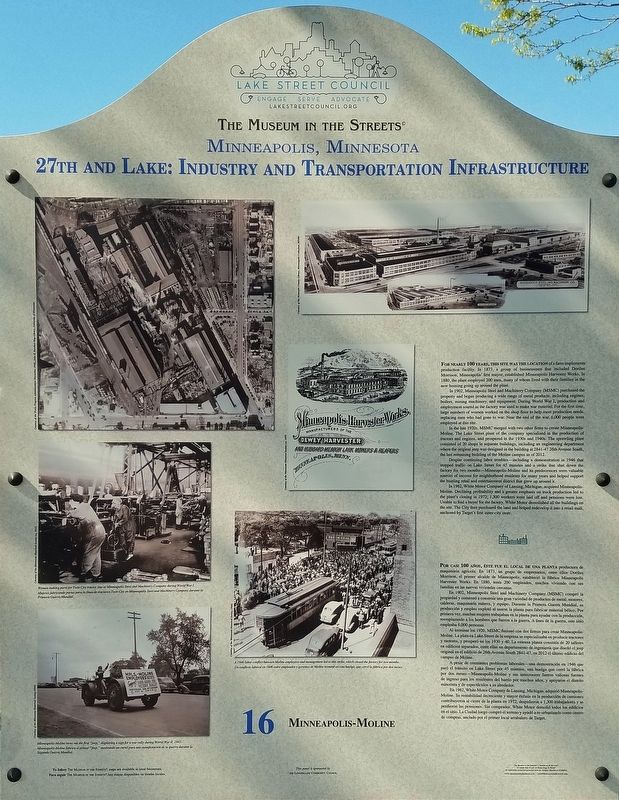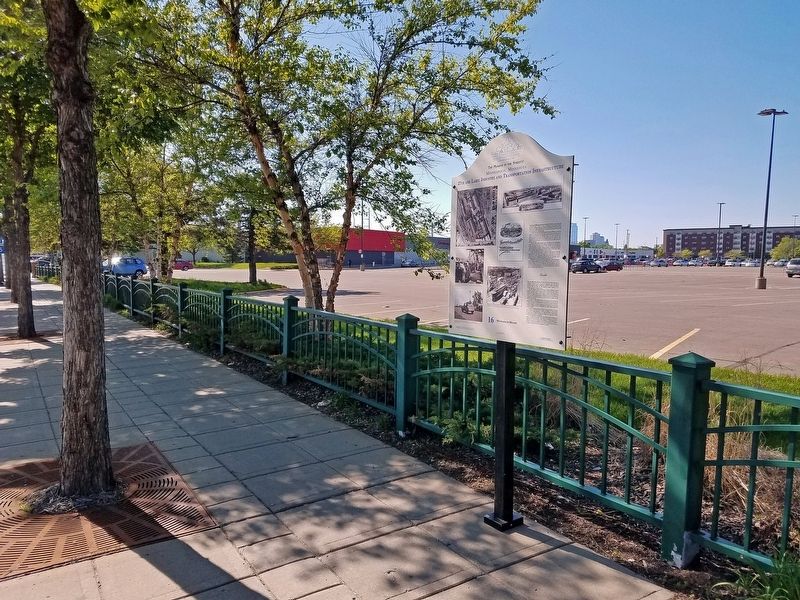Longfellow in Minneapolis in Hennepin County, Minnesota — The American Midwest (Upper Plains)
Minneapolis-Moline
The Museum in the Streets: Minneapolis, Minnesota
— 27th and Lake: Industry and Transportation Infrastructure —
For nearly 100 years, this site was the location of a farm implements production facility. In 1873, a group of businessmen that included Dorilus Morrison, Minneapolis' first mayor, established Minneapolis Harvester Works. In 1880, the plant employed 200 men, many of whom lived with their families in the new housing going up around the plant.
In 1902, Minneapolis Steel and Machinery Company (MSMC) purchased the property and began producing a wide range of metal products, including engines, boilers, mining machinery, and equipment. During World War I, production and employment soured as the factory was used to make war materiel. For the first time, large numbers of women worked on the shop floor to help meet production needs, replacing men who had gone to war. Near the end of the war, 6,000 people were employed at this site.
In the late 1920s, MSMC merged with two other firms to create Minneapolis-Moline. The Lake Street plant of the company specialized in the production of tractors and engines, and prospered in the 1930s and 1940s. The sprawling plant consisted of 20 shops in separate buildings, including an engineering department were the original jeep was designed in the building at 2841–47 26th Avenue South, the last remaining building of the Moline campus as of 2012.
Despite continuing labor troubles—including a demonstration in 1946 that stopped traffic on Lake Street for 45 minutes and a strike that shut down the factory for two months—Minneapolis-Moline and its predecessors were valuable sources of income for neighborhood residents for many years and helped support the bustling retail and entertainment district that grew up around it.
In 1962, White Motor Company of Lansing, Michigan, acquired Minneapolis-Moline. Declining profitability and a greater emphasis on truck production led to the plant's closing in 1972; 1,300 workers were laid off and pensions were lost. Unable to find a buyer for the factory, White Motor demolished all the buildings on the site. The City then purchased the land and helped redevelop it into a retail mall, anchored by Target's first inner-city store.
En 1902, Minneapolis Steel and Machinery Company (MSMC) compró la propiedad y comenzó a construir una gran variedad de productos de metal: motores, calderas, maquinaria minera, y equipo. Durante la Primera Guerra Mundial, su producción y empleo explotó al usarse la planta para fabricar material bélico. Por primera vez, muchas mujeres trabajaban en la planta para ayudar con la producción, reemplazando a los hombres que fueron a la guerra. A fines de la guerra, este sitio empleaba 6,000 personas.
Al terminar los 1920, MSMC fusionó con dos firmas para crear Minneapolis-Moline. La plata en Lake Street de la empresa se especializaba en producir tractores y motores, y prosperó en los 1930 y 40. La extensa planta consistía de 20 talleres en edificios separados, entre ellas un departamento de ingeniería que diseñó el jeep original en el edificio de 26th Avenue South 2841–47, en 2012 el último edificio del campus de Moline.
A pesar de constantes problemas laborales—una demostración en 1946 que paró el tránsito en Lake Street por 45 minutos, una huelga que cerró la fábrica por dos meses—Minneapolis-Moline y sus antecesores fueron valiosas fuentes de ingreso para los residentes del barrio por muchos años, y apoyaron el distrito minorista y de espectáculos a su alrededor.
En 1962, White Moter Company de Lansing, Michigan, adquirió Minneapolis-Moline. Su rentabilidad decreciente y mayor énfasis en la producción de camiones contribuyeron al cierre de a planta in 1972; despidieron a 1,300 trabajadores y se perdieron las pensiones. Sin comprador, White Motor demolió todos los edificios en el sitio. La Ciudad luego compró el terreno y ayudó a re-urbanizarlo como centro de compras, anclado por el primer local arrabalero de Target.
Erected 2012 by The Museum in the Streets®. (Marker Number 16.)
Topics and series. This historical marker is listed in these topic lists: Industry & Commerce • Labor Unions • War, World I • War, World II. In addition, it is included in the The Museum in the Streets®: Minneapolis, Minnesota series list. A significant historical year for this entry is 1873.
Location. 44° 56.91′ N, 93° 14.099′ W. Marker is in Minneapolis, Minnesota, in Hennepin County. It is in Longfellow. Marker is on Lake Street west of Minnehaha Avenue E, on the right when traveling west. Marker is facing the sidewalk at the edge of the Target parking lot. Touch for map. Marker is at or near this postal address: 2500 E Lake St, Minneapolis MN 55406, United States of America. Touch for directions.
Other nearby markers. At least 8 other markers are within walking distance of this marker. Snelling Avenue: African American Community (about 300 feet away, measured in a direct line); Longfellow School (about 300 feet away); 3010 Minnehaha Avenue South: Fire Station No. 21 (about 300 feet away); 3012 Minnehaha Avenue South: Lauritzen Wagon and Blacksmith Shop (about 300 feet away); 2700 East Lake: Coliseum Building / Freeman's Department Store (about 400 feet away); 2629 East Lake: Minnehaha Grill (about 500 feet away); 2721-23 East Lake: Lake Theater (approx. 0.2 miles away); Hiawatha-Minnehaha Corridor (approx. 0.2 miles away). Touch for a list and map of all markers in Minneapolis.
Also see . . . Wikipedia article on Minneapolis-Moline. The former large tractor and farm and industrial machinery producer. (Submitted on September 30, 2020.)
Credits. This page was last revised on February 12, 2023. It was originally submitted on September 29, 2020, by McGhiever of Minneapolis, Minnesota. This page has been viewed 423 times since then and 78 times this year. Photos: 1, 2. submitted on September 29, 2020, by McGhiever of Minneapolis, Minnesota. • Mark Hilton was the editor who published this page.

